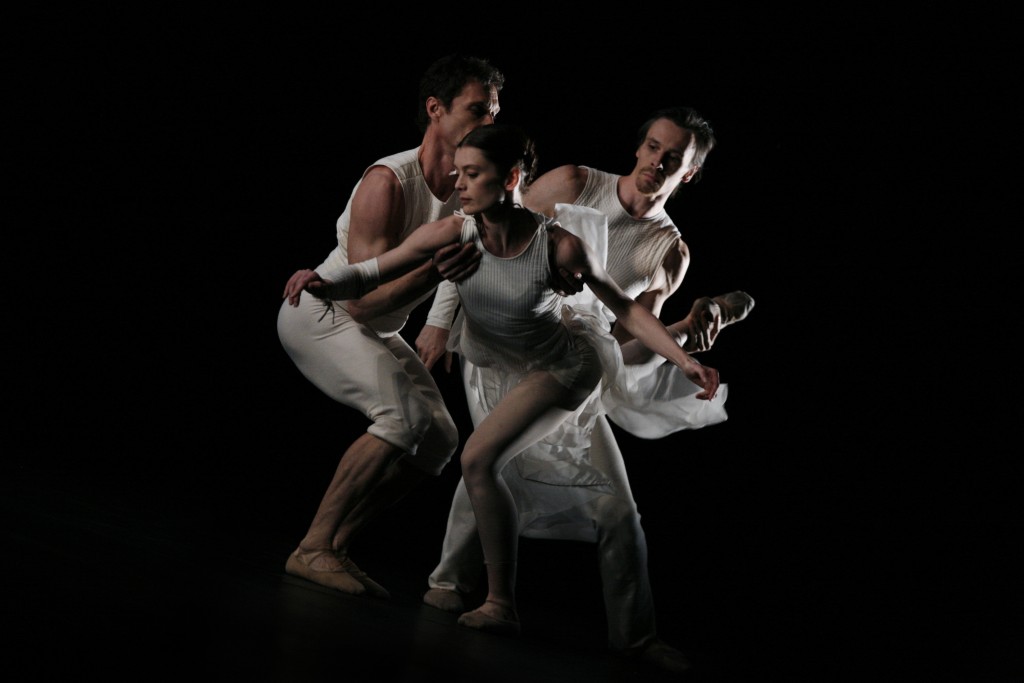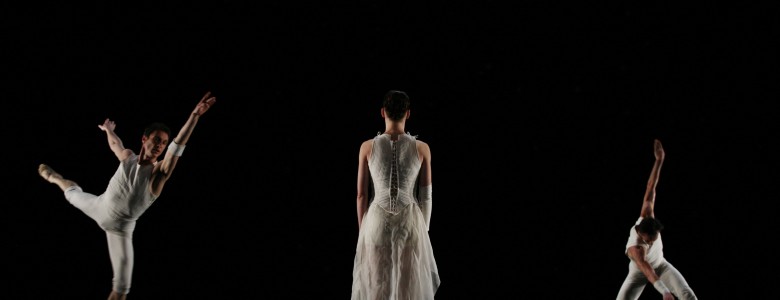O zlozony/O composite will be performed by the Pennsylvania Ballet from June 9 to June 12, 2016, at the Merriam Theater as part of the company’s Balanchine and Beyond program. See here for details.

The Pennsylvania Ballet’s performances of Trisha Brown’s O zlozony/O composite (2004) mark a major event: the first occasion that this work will be presented by an American dance company. Emblematic of her ever-expanding appetite for new creative challenges, it is the sole ballet that she created during her fifty-year career. Realized on commission from the venerable Paris Opera Ballet, the ballet’s premiere at the Palais Garnier in December 2004 met with great acclaim—but also wonder and surprise, given Brown’s longstanding reputation as one of the greatest experimental choreographers of the twentieth and twenty-first centuries.
Brown (b. 1936) embarked on her career in the 1960s and 1970s, dedicating herself to the invention of abstract movement vocabularies. Exploring the body’s relationship to gravity, its internal mechanical logic and its natural, as well as counter-acting momentums, she embraced a democratic approach to the simultaneous activation of movement impulses throughout the entirety of the body. Different from all major choreographers of her day, Brown’s dances were presented in alternative, outdoor sites, and primarily in international art galleries and museum exhibitions. Eschewing sets, costumes, music, storytelling, or psychological characterization, her dances offered audiences an unadorned aesthetic experience parallel to the abstract art of her contemporaries.
A major turning point in her artistic development occurred in 1979, when she first created a dance for the theatrical stage. This inaugurated her embrace of collaboration, with artists of her generation contributing sets, costumes and music to her productions. Brown entered a new phase of her career in 1998, when she directed Monteverdi’s opera L’Orfeo, and then in 2002, created a danced interpretation of Schubert’s Winterreise set to the poems of Wilhelm Müller.
The librettos for these works inspired Brown to introduce poetic imagery and lightly connotative gestures to her abstract movement—an approach that significantly influenced her work on O zlozony/O composite, for which the Paris Opera Ballet’s Director, Brigitte Lefèvre, gifted Brown three principal Paris Opera Ballet dancers—the “étoiles” Aurélie Dupont, Nicholas La Riche, and Manuel Legris—as participants in this novel creative experiment. Brown’s first step was to commission an original sound score from composer Laurie Anderson. Together the two artists selected a poem by Nobel Prize winning author, Czesław Milosz (1911–2004), in particular to his Ode to A Bird, (1959), whose first line, as rendered in Polish and English, provides the ballet’s title.
The text itself functioned as “readymade” libretto and shared touchstone in Brown and Anderson’s work together on a twenty-minute ballet comprised of ten two-minute sections. Anderson incorporated a whispered Polish version of the poem into her electronic soundscore’s resounding gongs, string sections, and percussive drumming. The poem served as a source for Brown’s infusion of imagery into the ballet’s movement; it also influenced the set design by Latvian-born, New York-based artist Vija Celmins. She expanded a longstanding motif in her prints and drawings—abstract renderings of a starry night sky—to a theatrical scale. Together the sets and costumes make for a monochromatic stage environment, which showcases the dancing’s delicacy and lyricism.
Brown’s ambition was to fuse her own idiosyncratic movement language with ballet’s technical vocabulary, of which she had only minimal experience. Aware that ballet choreography is organized through a codified vocabulary of preexisting positions, jumps, turns, shapes and elevations—each having its counterpart in short-hand French language terminology—she developed a new movement lexicon, instructing company veteran Diane Madden to create a simple alphabet of twenty-six movements, A, B, C, D, and on. The result was a series of gestures, closely related to Brown’s first explorations of abstract movement in the 1970s, and in which isolated body parts are configured in relation to the body’s center and its immediate surrounding, but the actions barely travel in space. Madden then sequenced these alphabetic/kinesthetic units by spelling out, letter by letter, the first ten lines of Edna St. Vincent Millay’s 200-line lyric poem, Renascence (1912), which begins: A.L.L. I. C.O.U.L.D. S.E.E. F.R.O.M.W.H.E.R.E.I.S.T.O.O.D.
In an intermediary step, Brown invited former New York City ballet dancer, Emily Coates, to set Madden’s simple movement phrase on pointe. Brown gathered insights as to how her relaxed, released, personal movement language would be assimilated by ballet dancers, whose bodies are imprinted by years of training, characterized by uplifted physical carriage, effortful muscular actions, and cultivated stage presences—artifices of ballet performance that run counter to Brown’s artistic principles.
Subsequently three members of Brown’s company, Neal Beasley, Cori Olinghouse, and Todd Stone created nine variations on the alphabet, imbuing its movements with greater dynamism and flourish. Brown worked directly with Olinghouse to create the female solo. It was transmitted to Dupont when the étoiles visited New York, working with Brown to transform the existing phrase material into a balletic vocabulary of turned out positions, tendus, relevés, attitudes, and grand battements.
Brown finalized the dance in Paris, directing the étoiles to bring more complex ballet partnering into her choreography. Encouraging them to engage with each others’ bodies in an organic fashion, she also deliberately challenged ballet’s gendered conventions in which a male dancer supports and lifts a woman (but never the opposite). Instead they invented support systems involving trios, male-male duets, and instances where the woman gently manipulates a male dancer’s body.
Performed in all-white costumes designed by Elizabeth Cannon, whose stitching and armbands recall the attire used in the aristocratic art of fencing (considered a source for ballet’s technical vocabulary), the choreography joins recognizable ballet moves—pirouettes, expansive leaps through space, and graceful port de bras—with Brown’s vocabulary of rapid undulations of the spine, head and limbs, the use of simple walking, and the creation of linear as well as asymmetrical physical geometries. The female dancer alternates between performing in pointe shoes, and performing in ballet slippers, more suitable to modern dance.
Milosz’s poem’s evocations of “a galleried night . . . and a galaxy in its body,” find their counterpart in the ballet’s celestial environment, an expansive cover for the ballet’s unfolding in a succession of fluidly changing tableaux. The dancing—as pervaded by recurrent veiled references to the poem’s bird imagery of “fluttering palms,” landings “in a harp of a shadow” and beating wings, and as performed against the slurry, sensual, melodic sounds of the Polish language recitation of Milosz’s poem—hints at longing and melancholy, a slow awakening from the realm of dreams.
—Susan Rosenberg
The author gratefully acknowledges Neal Beasley, Elizabeth Cannon, Emily Coates, Carolyn Lucas, Cori Olinghouse, and Todd Stone for their generosity in granting interviews, and engaging in informal conversations, all of which significantly contributed to the writing of this text.
Photos: Julieta Cervantes

